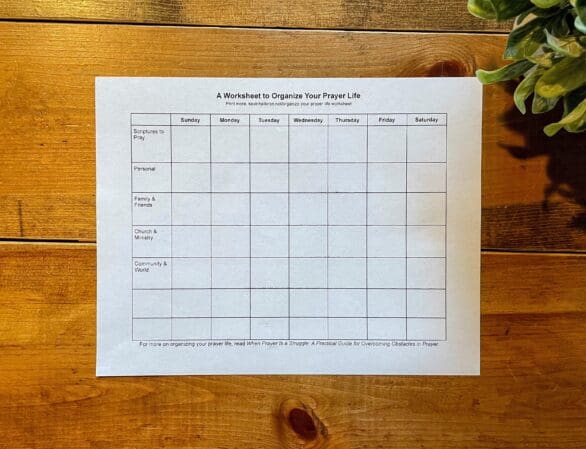But when you pray, go into your room and shut the door and pray to your Father who is in secret. And your Father who sees in secret will reward you. (Matthew 6:6)
Prayer is an offer of a lifetime. The God of the universe invites us into His presence to worship Him, confess our sins, present our requests before Him, and intercede for our broken world.
It’s like having a direct line to the president, except infinitely better. We never go to God’s voicemail. God’s will can’t be blocked by congress. God’s power isn’t confined by term limits. And what president can say, “If you ask me anything in my name, I will do it” (John 14:14) like Jesus did?
One ordinary, yet powerful, way to build your life upon the glorious gift of prayer is to think intentionally through a daily prayer routine. Intentionality shows God that you take His gracious offer to hear our prayers seriously, and will help you invest more of the short time you have on earth in His kingdom priorities.
A Suggested Method
You may feel overwhelmed with the list of potential to-dos ahead of you. Don’t be. If you take five minutes today to think through goals for prayer and a simple plan, you’ll be surprised at how productive and fruitful your prayers can be.
1. Pray for prayer.
God can help you create or improve a prayer routine. Ask Him for faith to believe He hears you, help in thinking through basic elements of a prayer routine, creativity in implementation, wisdom for overcoming internal weaknesses and external obstacles to prayer, and a desire to persevere.
2. Plan time.
The adage “fail to plan and you will plan to fail” is often true for our prayer lives because of busyness and distraction.
I recommend scheduling regular time for extended prayer into your daily, weekly, and monthly routines. Your best time for prayer is often when you have mental energy and available time. And if no such time comes to mind, consider what to remove in your life so you will be more available to seek the Lord.
In addition to these regular extended times of prayer, what other ways can you build prayer into your life? Can you say a short prayer at the start of a workday? Before a meal? When you sit in your car? You may only have thirty seconds to commune with your heavenly Father, but that’s thirty seconds well-invested.
3. Engage Scripture.
The more we incorporate Scripture into our prayers, the more powerful our prayers will be and the more they will focus on God’s priorities. As you read Scripture, note verses and passages you’d like to incorporate into your prayers. I use a journaling Bible and will often write key ideas and prayers in the margin.
Here are some of my favorites passages to turn to prayer:
- Matthew 6:9–13 (The Lord’s Prayer)
- Matthew 6:33
- Ephesians 1:15–23
- Romans 12:1–2
- Proverbs 3:5–6
- John 15:1–10
- James 1:5
- Psalm 2
- Psalm 23
Many Scripture passages adapt easily for prayer, but you will find special value in praying the prayers of the Bible.
4. Design Structure.
Giving yourself structure in prayer provides a path for your mind to follow so that if (and when) you get off track, you can hop back on. This step is like the skeleton of your prayer routine.
A good structure will bring you through different types of prayer and remind you to intercede for a variety of people, events, and kingdom priorities. You might combine several of the ideas below or create your own structure. The key idea is to know the basic shape of your prayer time.
Suggested structures for prayer:
- The A-C-T-S Pattern (Adoration, Confession, Thanksgiving, Supplication)
- The six petitions of the Lord’s Prayer
- Responding to daily Bible reading in prayer
- A prayer worksheet divided by days of the week (like in the example below)
- An app like PrayerMate
- Prayer cards
- A prayer journal

5. Organize priorities.
This step puts meat on the bones of the structure you designed. The general organizational principle rings true: if you have something you’d like to pray for, it needs to have a logical place in your prayer plan. (Although not everything will have a logical category, so you might make a “Random” category like I did.)
I recommend gathering Scriptures you’d like to pray, a list for intercession (for family, your church, the world), and any other priorities you have. Then think through your structure and fill it in with specifics. You will find a journal, worksheet, prayer app, or digital notepad helpful for putting the meat on the bones of your prayer life.
6. Tweak as you go.
The exercise of planning your prayer time never really ends, and that’s good. Prayer priorities change. As more Scriptures or requests come to mind that you’d like to bring before the throne of grace, add them to your plan. As certain requests expire or become less important, cycle them off your routine prayer. Maintaining a fresh prayer list only takes minutes each month.
How This Looks in Practice
Here’s a glimpse of my daily prayer routine: I start first thing in the morning by reading Scripture. My reading time is mixed with meditation on Scripture (which some call a natural bridge to prayer) and praying in response to Scripture. This usually takes 25 minutes. Then I transition to my prayer worksheet (or digital prayer cards in the free PrayerMate app) that has the following structure:
- Scripture to Pray
- Personal Requests
- Family & Friends
- Church & Ministry
- Community & World
- Random & Big Prayers
As time allows, I spend about fifteen minutes praying through my requests in the previous six categories. My young daughter often interrupts my prayer time, but knowing my prayer to-dos for that day make it easy to get back on track after interruptions. My daily prayer time varies after this morning routine, but generally I try to scatter shorter moments of prayer throughout my day.
Yes, on the surface, your prayer life may look ordinary like mine. But our God can and does use the ordinary to do extraordinary things (Ephesians 3:20)!
Bear Long-Term Fruit in Prayer
The conviction behind this article is that if our prayer priorities and requests are organized and we have a plan to pray through them, we will pray more faithfully and fruitfully over the long run.
You’ll face obstacles, battle laziness and sometimes the desire to pray, but God is worth seeking with all our hearts. Getting a prayer plan together and implemented will help you take advantage of the glorious gift He has given us in prayer.







